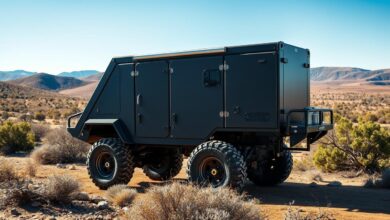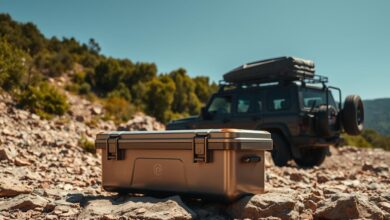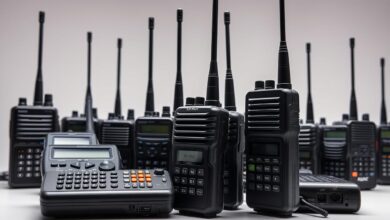The Ultimate Guide to Dual Battery Setups for Off-Roaders
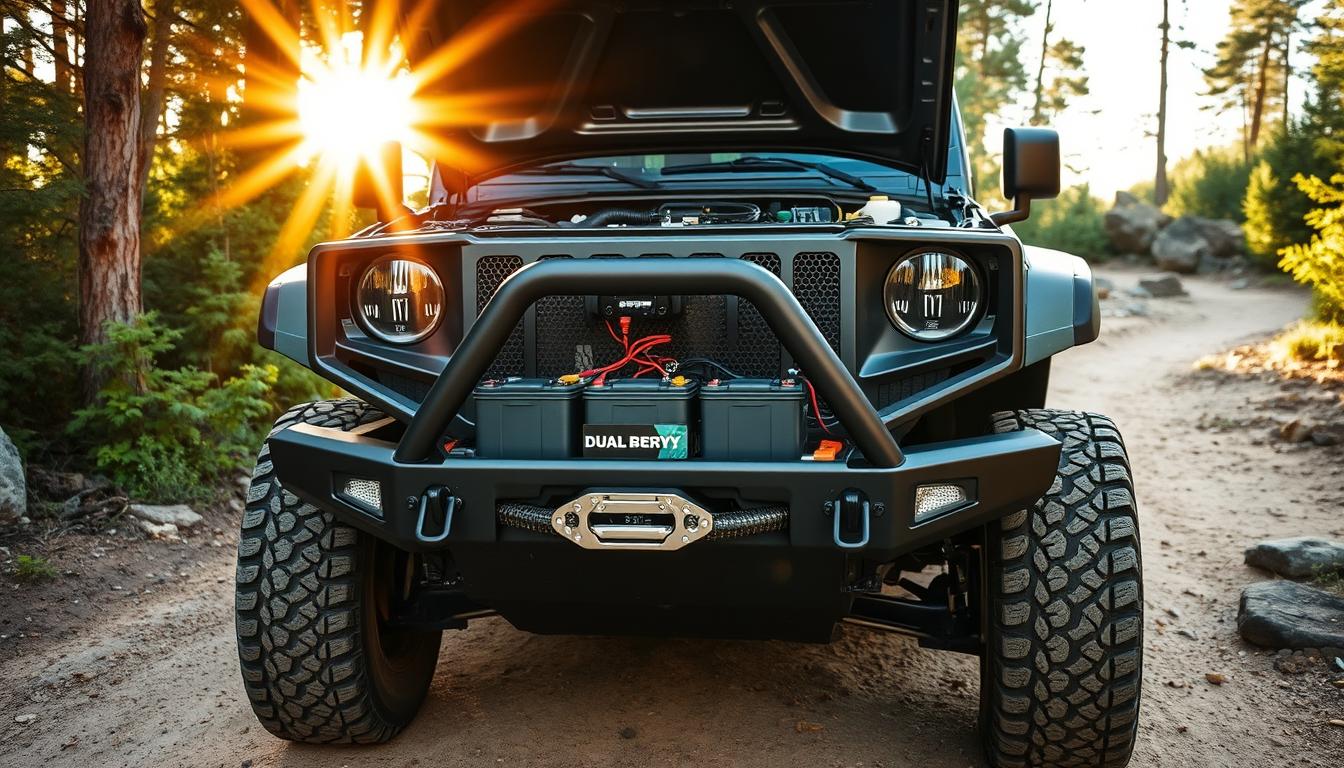
As an off-roader, you know how important a reliable power system is for your vehicle. Dual battery systems are a game-changer. They give you extra power for accessories and keep your main battery safe.
With a dual battery setup, you can power extra things like fridges, lights, and entertainment. A dual battery isolator or controller helps manage charging. It stops power from draining between batteries.
Key Takeaways
- Dual battery systems provide additional power for accessories.
- A battery isolator or controller is essential for managing charging.
- Proper maintenance can extend the lifespan of dual battery systems.
- Advanced systems may incorporate a solenoid or DC-DC charger.
- EcoFlow Alternator Chargers can charge portable power stations quickly.
Understanding Dual Battery Setups
For those who love off-roading, knowing about dual battery setups is key. A dual battery system gives a steady power supply. This means your off-roading trips won’t stop because of battery issues.
What is a Dual Battery Setup?
A dual battery setup has two batteries in your vehicle. One is for starting the engine, and the other is a deep cycle battery for accessories. This setup lets you use extra gear like winches and lights without harming the main battery.
Key benefits include more power, less chance of being stuck with a dead battery, and a balanced electrical system.
Benefits of Using Dual Batteries
Dual batteries bring many perks for off-roaders. They offer a backup power source and let you power accessories without hurting the main battery.
- Increased reliability and reduced risk of battery drain
- Enhanced power management for accessories
- Better overall electrical system balance
Common Components of Dual Battery Systems
A typical dual battery system has several important parts. These are:
| Component | Description |
|---|---|
| Deep Cycle Battery | Designed for discharging and recharging many times, perfect for accessories. |
| Battery Isolator | Makes sure the primary and secondary batteries charge right without draining each other. |
| Battery Monitor | Helps you keep an eye on both batteries’ charge levels, keeping you informed. |
| Wiring and Fuses | Good wiring and fuses are key for safety and efficiency, protecting against electrical surges. |
Knowing about dual battery setups and their parts helps you make smart choices for your off-road vehicle’s power system.
Choosing the Right Batteries
Off-roaders need batteries that can handle tough adventures. Your vehicle’s battery is key to keeping important systems working. It’s more than just a part; it’s a lifeline.
Types of Batteries for Off-Roading
Types of Batteries for Off-Roading
There are many batteries good for off-roading, each with special features. The top picks are:
- AGM (Absorbent Glass Mat) Batteries: AGM batteries are tough and handle vibration well. They’re a favorite among off-roaders.
- Lithium-ion Batteries: Lithium-ion batteries pack a lot of power and last a long time. They’re getting more popular for off-road use.
- Deep Cycle Batteries: Deep cycle batteries give steady power for a long time. They’re great for off-roaders who use winches and fridges.
Factors to Consider When Selecting Batteries
When picking batteries for off-roading, think about a few things. You should look at:
- Capacity and Reserve Capacity: Make sure the battery can handle your power needs and has enough reserve for surprises.
- Cold Cranking Amps (CCA): If you go to cold places, choose a battery with high CCA.
- Maintenance Requirements: Some batteries need more care than others. Think about how much time you can spend on battery upkeep.
- Compatibility: Make sure the battery fits your vehicle’s electrical system and any extra accessories.
By thinking about these points and picking the right battery, you’ll have a great off-roading time.
System Configuration Options
How you set up your dual battery system is key to its success. You must think about how the batteries will work together.
Parallel vs. Series Connection
Dual batteries can be set up in two ways: parallel or series. A parallel connection links both batteries’ positive and negative terminals together. This keeps the voltage the same but increases the capacity, letting you use it longer without needing to recharge.
A series connection links the positive terminal of one battery to the negative of the other. This setup increases the voltage but keeps the capacity the same. While less common in off-roading, it’s useful for certain high-voltage needs.
| Configuration | System Voltage | System Capacity |
|---|---|---|
| Parallel | Same as single battery | Double the capacity |
| Series | Double the voltage | Same as single battery |
Isolators vs. Separators
It’s important to manage how batteries charge and discharge. Battery isolators and battery separators help control this flow.
A battery isolator lets the alternator charge both batteries while keeping them separate. It uses a relay or electronic device to isolate the batteries when the engine is off.
A battery separator is more advanced. It not only isolates but also manages charging more smartly. It checks the charge of both batteries and decides when to connect or separate them based on certain conditions.
- Battery isolators are simpler and cheaper.
- Battery separators offer better management and can extend battery life.
Choosing between parallel or series, and isolators or separators, depends on your needs. Knowing these options helps make your dual battery system work better and last longer.
Installation Process Overview
A well-planned dual battery installation can greatly enhance your off-road vehicle’s electrical capabilities. Before you begin, it’s essential to understand the key considerations and steps involved in the process.
Pre-Installation Considerations
Before installing a dual battery system, you need to consider several factors to ensure a successful upgrade. These include:
- Assessing your vehicle’s electrical system and its capacity to handle the additional battery
- Choosing the right batteries and components for your specific needs
- Planning the installation layout and ensuring proper ventilation
- Selecting the appropriate wiring and electrical connectors
It’s also important to consult your vehicle’s manual. If you’re unsure about any aspect of the installation, consider seeking professional advice.
Step-by-Step Installation Guide
Here’s a step-by-step guide to help you through the dual battery installation process:
- Prepare your vehicle: Ensure your vehicle is parked on a level surface and apply the parking brake.
- Disconnect the negative cable: Start by disconnecting the negative (black) cable from the battery to prevent any accidental short circuits.
- Install the second battery: Mount the second battery in a suitable location, ensuring it’s secure and has proper ventilation.
- Connect the batteries: Use a battery isolator or separator to connect the two batteries, following the manufacturer’s instructions.
- Update your electrical system: Upgrade your wiring and electrical connectors as needed to handle the increased electrical load.
By following these steps and considering the pre-installation factors, you can ensure a successful dual battery installation. This will enhance your off-road vehicle’s electrical capabilities.
Essential Tools and Equipment
To make installing a dual battery setup easy, you need the right tools and parts. A good toolkit makes the job simpler and helps avoid problems.
Tools Required for Installation
Installing a dual battery system needs various tools. Here are some key ones:
- Wiring and Cables: You need high-quality wiring and cables for safe connections.
- Fuses and Circuit Breakers: These protect your electrical system from damage.
- Battery Isolators or Separators: They ensure your batteries charge right and don’t drain each other.
- Battery Monitors: A battery monitor tracks your battery’s health and performance.
- Basic Hand Tools: You’ll also need tools like wrenches, pliers, and screwdrivers for the job.
Recommended Brands and Products
Choosing the right products for your dual battery system is important. Here are some top brands:
- Redarc: They’re known for their top-notch battery managers and isolators.
- Blue Sea Systems: They offer a variety of products, including battery monitors and panels.
- Schneider Electric: They provide reliable charging solutions and other essential components.
When picking products, look at compatibility, durability, and what other customers say. This ensures you get the best for your setup.
Maintaining Your Dual Battery Setup
Keeping your dual battery setup in top shape can make it last longer. A well-looked-after system means your off-road vehicle will be reliable and work its best.
Routine Checks and Maintenance Tips
To keep your dual battery setup running smoothly, you need to do a few things regularly.
- Battery Health: Check how both batteries are doing often. Use a battery monitor or a multimeter to see how they’re faring.
- Connection Cleaning: Corrosion can really hurt your battery’s performance. Clean the terminals and connections regularly with a wire brush and the right cleaning solution.
- Cable Condition: Look for any wear or damage on the cables. If you find any, replace them to avoid electrical problems.
Troubleshooting Common Issues
Even with regular care, problems can pop up. Here are some common issues and how to fix them:
- Battery Not Charging: Make sure the alternator output, voltage regulator, and wiring are all working right.
- Uneven Battery Drain: Make sure both batteries are the same type and age. Also, check for any unwanted power drains.
- System Not Isolating Batteries: Check that the isolator or separator is working as it should.
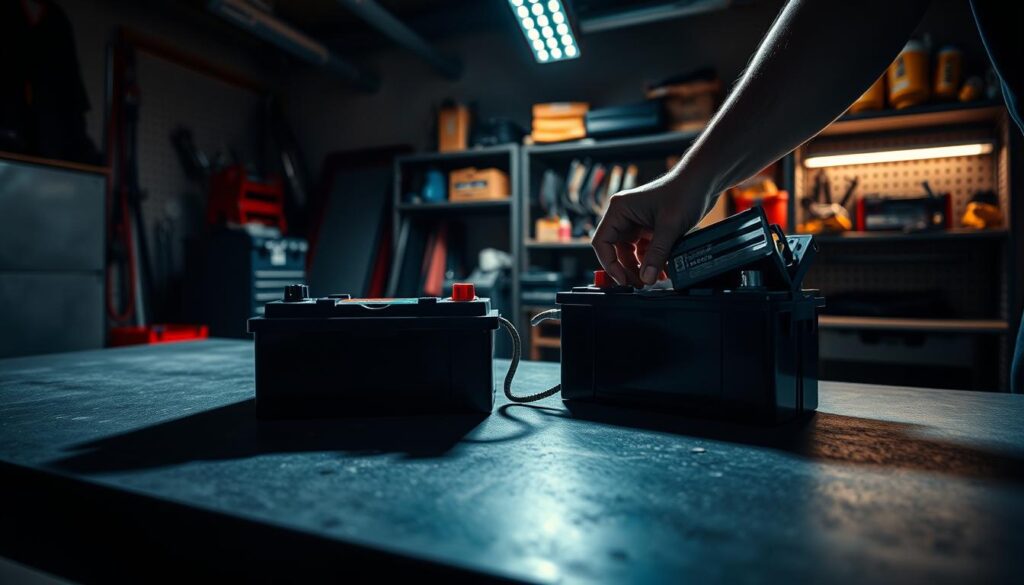
By sticking to these maintenance tips and solving common problems, you can keep your dual battery setup in great shape. This will make your off-roading adventures even better.
Optimizing Battery Performance
To get the most from your dual battery system, focus on charging, discharging, and maintenance. A well-kept system boosts your off-roading fun and extends battery life.
Best Practices for Charging and Discharging
Keeping your batteries healthy starts with right charging and discharging. Here are some key tips:
- Check your battery’s charge often to prevent deep discharging, which harms battery life.
- Choose a charger that fits your battery type and set it to the right mode.
- Don’t overcharge, as it can damage your battery and lower its performance.
For more on dual battery systems, including charging and discharging, check out our guide on dual battery systems.
How to Extend Battery Lifespan
To make your batteries last longer, do regular maintenance and use them wisely. Here are some helpful tips:
- Regularly clean your batteries to prevent corrosion and keep terminals in good shape.
- Store your batteries in a cool, dry spot when not using them to slow down wear.
- Avoid extreme temperatures, as they can hurt battery performance and life.
By following these tips, you can improve your dual battery system’s performance and life. This means more fun and less stress on your off-roading adventures.
Safety Considerations
When you install and keep a dual battery setup in your off-road vehicle, safety is key. It’s important to keep electrical safety in mind to avoid accidents and harm to your vehicle’s electrical system.
Electrical Safety Guidelines
To keep things safe, follow these tips:
- Always disconnect the battery before starting work on the electrical system.
- Use insulated tools to prevent short circuits.
- Ensure all connections are secure and protected from corrosion.
- Follow the manufacturer’s instructions for battery installation and maintenance.
By sticking to these off-road vehicle safety tips, you can lower the risk of electrical shock or fire.
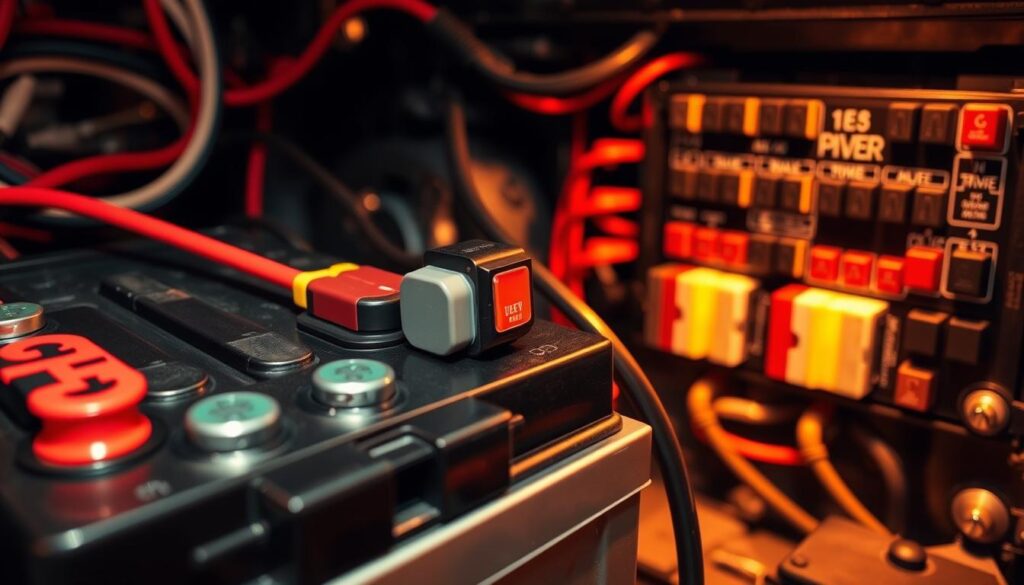
Protecting Your Vehicle’s System
Keeping your vehicle’s electrical system safe is more than just following safety rules. It also needs careful planning and upkeep.
Here are some things to think about:
- Use a battery isolator or separator to prevent drain from one battery to the other.
- Regularly check the condition of your batteries and their connections.
- Ensure your charging system is compatible with your dual battery setup.
By taking these steps, you can enjoy off-road adventures safely. You’ll know your vehicle’s electrical system is safe and dependable.
Conclusion and Final Thoughts
When you start off-roading, having a good power source is key. Dual battery systems are great for off-road vehicles. They keep your gadgets and appliances running smoothly.
Learning about dual battery systems and choosing the right batteries can make your off-road trips better. Lithium iron phosphate (LFP) batteries are tough and reliable, loved by many off-road fans.
Key Takeaways
A good dual battery system keeps your main battery safe, even when you’re using appliances without the engine on. This is super helpful for campers and off-road lovers who need their gadgets in the wild.
Embracing Off-Grid Adventures
With a dual battery system, you can enjoy the outdoors without worrying about power. It’s perfect for camping in the Australian outback or tackling tough trails. A solid power solution is vital for a great adventure.
FAQ
What is the main benefit of a dual battery setup for off-roaders?
A dual battery setup keeps your vehicle’s electrical systems running. This is true even when the main battery runs out.
What type of batteries are best suited for off-roading?
Deep cycle batteries are great for off-roading. They can handle deep discharges and recharge many times. This makes them perfect for powering accessories and equipment on long trips.
How do I choose the right battery isolator for my dual battery system?
When picking a battery isolator, think about your batteries, the current rating, and voltage needs. Make sure it fits your system well for the best performance.
Can I install a dual battery system myself, or do I need professional help?
Installing a dual battery system yourself is possible. But, if you’re not sure or lack experience, it’s safer to get professional help.
How often should I perform routine checks on my dual battery setup?
Check your dual battery system every 3-6 months. Look for wear, corrosion, and make sure it’s working right. This keeps your batteries in top shape.
What are the safety considerations when working with dual battery systems?
When working with dual battery systems, safety is key. Wear protective gear, avoid short circuits, and ensure insulation. This prevents electrical shock and damage to your vehicle’s electrical system.
How can I optimize the performance of my dual battery setup?
To get the most out of your dual battery setup, charge and discharge wisely. Avoid deep discharging and maintain your batteries well. This keeps them working as they should.
What are the key factors to consider when selecting batteries for my dual battery setup?
When choosing batteries, look at the type, capacity, cold cranking amps, and reserve capacity. Also, make sure they’re compatible with your vehicle and off-roading needs.

